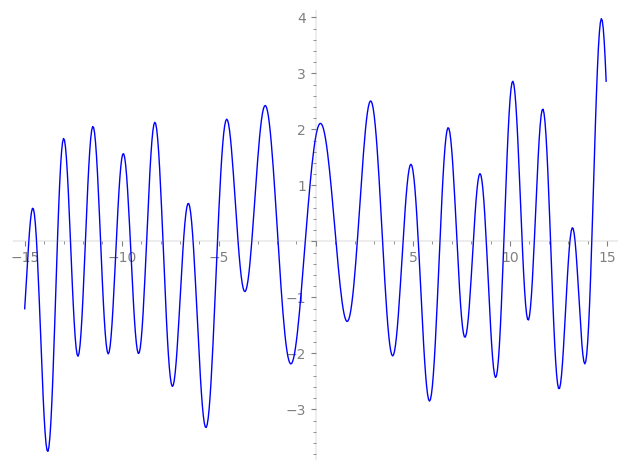| L(s) = 1 | + (0.5 + 0.866i)3-s + (−2.5 + 4.33i)5-s + (13 − 22.5i)9-s + (3.5 + 6.06i)11-s + 23·13-s − 5·15-s + (−12.5 − 21.6i)17-s + (−31 + 53.6i)19-s + (43 − 74.4i)23-s + (−12.5 − 21.6i)25-s + 53·27-s − 29·29-s + (−6 − 10.3i)31-s + (−3.5 + 6.06i)33-s + (75 − 129. i)37-s + ⋯ |
| L(s) = 1 | + (0.0962 + 0.166i)3-s + (−0.223 + 0.387i)5-s + (0.481 − 0.833i)9-s + (0.0959 + 0.166i)11-s + 0.490·13-s − 0.0860·15-s + (−0.178 − 0.308i)17-s + (−0.374 + 0.648i)19-s + (0.389 − 0.675i)23-s + (−0.100 − 0.173i)25-s + 0.377·27-s − 0.185·29-s + (−0.0347 − 0.0602i)31-s + (−0.0184 + 0.0319i)33-s + (0.333 − 0.577i)37-s + ⋯ |
\[\begin{aligned}\Lambda(s)=\mathstrut & 980 ^{s/2} \, \Gamma_{\C}(s) \, L(s)\cr =\mathstrut & (0.701 + 0.712i)\, \overline{\Lambda}(4-s) \end{aligned}\]
\[\begin{aligned}\Lambda(s)=\mathstrut & 980 ^{s/2} \, \Gamma_{\C}(s+3/2) \, L(s)\cr =\mathstrut & (0.701 + 0.712i)\, \overline{\Lambda}(1-s) \end{aligned}\]
Particular Values
| \(L(2)\) |
\(\approx\) |
\(1.886319868\) |
| \(L(\frac12)\) |
\(\approx\) |
\(1.886319868\) |
| \(L(\frac{5}{2})\) |
|
not available |
| \(L(1)\) |
|
not available |
\(L(s) = \displaystyle \prod_{p} F_p(p^{-s})^{-1} \)
| $p$ | $F_p(T)$ |
|---|
| bad | 2 | \( 1 \) |
| 5 | \( 1 + (2.5 - 4.33i)T \) |
| 7 | \( 1 \) |
| good | 3 | \( 1 + (-0.5 - 0.866i)T + (-13.5 + 23.3i)T^{2} \) |
| 11 | \( 1 + (-3.5 - 6.06i)T + (-665.5 + 1.15e3i)T^{2} \) |
| 13 | \( 1 - 23T + 2.19e3T^{2} \) |
| 17 | \( 1 + (12.5 + 21.6i)T + (-2.45e3 + 4.25e3i)T^{2} \) |
| 19 | \( 1 + (31 - 53.6i)T + (-3.42e3 - 5.94e3i)T^{2} \) |
| 23 | \( 1 + (-43 + 74.4i)T + (-6.08e3 - 1.05e4i)T^{2} \) |
| 29 | \( 1 + 29T + 2.43e4T^{2} \) |
| 31 | \( 1 + (6 + 10.3i)T + (-1.48e4 + 2.57e4i)T^{2} \) |
| 37 | \( 1 + (-75 + 129. i)T + (-2.53e4 - 4.38e4i)T^{2} \) |
| 41 | \( 1 + 204T + 6.89e4T^{2} \) |
| 43 | \( 1 + 178T + 7.95e4T^{2} \) |
| 47 | \( 1 + (-16.5 + 28.5i)T + (-5.19e4 - 8.99e4i)T^{2} \) |
| 53 | \( 1 + (226 + 391. i)T + (-7.44e4 + 1.28e5i)T^{2} \) |
| 59 | \( 1 + (-60 - 103. i)T + (-1.02e5 + 1.77e5i)T^{2} \) |
| 61 | \( 1 + (-460 + 796. i)T + (-1.13e5 - 1.96e5i)T^{2} \) |
| 67 | \( 1 + (-150 - 259. i)T + (-1.50e5 + 2.60e5i)T^{2} \) |
| 71 | \( 1 - 520T + 3.57e5T^{2} \) |
| 73 | \( 1 + (-185 - 320. i)T + (-1.94e5 + 3.36e5i)T^{2} \) |
| 79 | \( 1 + (-506.5 + 877. i)T + (-2.46e5 - 4.26e5i)T^{2} \) |
| 83 | \( 1 - 636T + 5.71e5T^{2} \) |
| 89 | \( 1 + (-146 + 252. i)T + (-3.52e5 - 6.10e5i)T^{2} \) |
| 97 | \( 1 - 1.38e3T + 9.12e5T^{2} \) |
| show more | |
| show less | |
\(L(s) = \displaystyle\prod_p \ \prod_{j=1}^{2} (1 - \alpha_{j,p}\, p^{-s})^{-1}\)
Imaginary part of the first few zeros on the critical line
−9.557362254803801152961214019553, −8.720610361147025841921867721876, −7.87517708968028144757327102986, −6.82098372492757166277130631601, −6.32519153791153022071215226233, −5.07058406709113345321093074028, −4.01007950189869516411631181433, −3.30222370538920811756429902841, −1.95076871011351465883411178091, −0.54768538601242965769033525709,
1.03431446025681599126858838319, 2.13292438950492262601301988211, 3.43499261969073760872123636792, 4.48882180682028855818488605379, 5.27421459406670266095904731332, 6.38788337774839780455465706008, 7.26682636281730129561541847335, 8.109516767940463180395512845363, 8.776158133476374440988373415558, 9.680829146742512283245697314442

